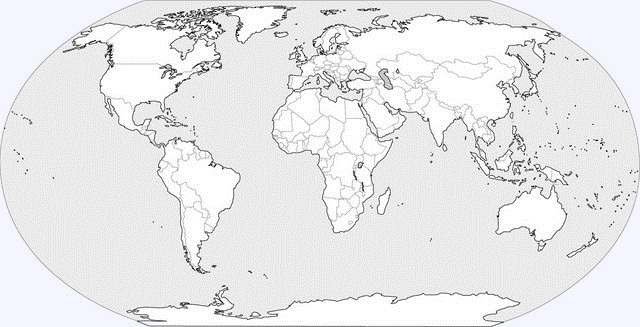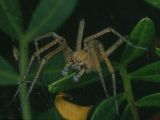|
Nombre común en ingles:
Spiny-legged sac spiders
Nombre común en castellano:
Se desconoce
Familias similares:
Género tipo:
Liocranum L. Koch, 1866
Diagnosis:
Small to medium-sized araneomorph
spiders; two tarsal claws; ecribellate; entelegyne; eight
entelegyne; eight eyes (sometimes reduced); female with posterior
median spinnerets flattened; posterior spinnerets with cylindrical
gland spigots; male palp with median apophysis.
Caracteres descriptivos:
Caparazón:
as wide as long or longer than wide, narrower in eye region. Esternón:
scutiform, rebordered. Ojos: eight; in two rows (4:4);
Liocranidae with eyes usually close together; anterior row straight
and posterior row procurved or recurved; Phrurolithinae with
anterior row procurved; Cybaeodinae (Andromma) with anterior median
eyes large and their axes divergent given the impression of a split
retina (laterally pale, mesally dark), eyes sometime reduced to
four. Quelíceros: cheliceral furrow usually with teeth. Piezas bucales:
labium not or barely longer than wide, not extending beyond middle
of endites; endites not narrowed medially. Patas: two claws;
tibiae and metatarsi I and II in many taxa armed below with
biseriate row of numerous long spines with distinct bases; tarsi
with or without scopulae. Palpo femenino:
tarsus spinose with finely toothed claw. Abdomen: oval;
dorsal scutum present in Phrurolithinae. Hileras:
posterior and median spinnerets with cylindrical gland spigots;
median spinnerets of females laterally flattened; distal segment of
posterior spinnerets distinct and conical; colulus unpaired, with
setae. Sistema respiratorio:
two booklungs; trachea restricted to abdomen, spiracle clese to
spinnerets. Genitalia: entelegyne; epigyne variable; male
palp bulbus usually with median apophysis (absent in
Phrurolithinae); embolus variable; tibia with apophyses; male palpal
femur with modifications (Phrurolithinae). Tamaño corporal:
3-15 mm. Color: varies from pale yellow to brownish with
indistinct pattern on abdomen or uniform reddish yellow, or blackish
brown.
Estatus taxonómico:
Coddington & Levi (1991) listed the family in the Dionychae and
considered then the sistergroup of the gnaphosoids, in later
analyses they are simply put in the unresolved Dionychae clade.
According to Platnick & Baptista (1995), the liocranids as a family
still lack distinct synapomorphies. This was corroborated by
Bosselaers & Jocqué (2002), who questioned the monophyly of the
family.
Distribución: mundial.

Estilo de vida: Liocranids
are free-living ground-dwelling spiders inhabiting forest litter;
some genera are asociated with ants and termites.
Bibliografía:
-
Bosselaers, J. &
Jocqué, R. 2002. Studies in Corinnidae: cladistic analysis of 38
corinnid and liocranid genera, and transfer of Phrurolithinae. Zool.
Scripta 31: 241-270.
-
Dippenaar-Schoeman, A.S. & Jocqué,
R. 1997. African Spiders: An Identification Manual. Plant Protection
Res. Inst. Handbook, no. 9, Pretoria, 392 pp.
-
Platnick, N.I. &
Baptista, R. 1995. On the spider genus Attacobius (Araneae, Dionycha).
Am. Mus. Novit. 3120: 1-9.
-
Ubick, D. & Richman,
D.B. 2005b. Liocranidae. pp. 162-163 in Ubick, D., Paquin, P.,
Cushing, P.E. & Roth, V. (Eds) 2005. The Spiders of North America.
An Identification Manual. American Arachnological Society.
8 géneros y 19 especies presentes en la Península Ibérica:
|
| |
- A.
lineata
(Simon, 1878) |
|
| |
- A. annulipes
Simon, 1878 |
| |
- A. brunnea
(Blackwall, 1833) |
| |
- A. cuprea
Menge, 1873 |
| |
- A. inopina
O. P.-Cambridge, 1866 |
| |
- A. lusatica
(L. Koch, 1875) |
| |
- A. proxima
(O. P.-Cambridge, 1871) |
|
| |
- A. fuscus
Westring, 1851 |
| |
- A. humilis
Simon, 1932 |
|
| |
- C. liocraninus
(Simon, 1913) |
| |
- C. mallorcensis
Wunderlich, 2008 |
|
| |
- L. striata
(Kulczynski, 1882) |
|
| |
- L. major
Simon, 1878 |
| |
- L. rupicola
(Walckenaer, 1830) |
| |
- L. segmentatum
Simon, 1878 |
|
| |
- M. mauritanicus
Simon, 1909 |
| |
- M. tenuissimus
(L. Koch, 1866) |
|
| |
- S. celans
(Blackwall, 1841) |
| |
- S. palliardi
(L. Koch, 1881) |
| |
|
 |